engine Lancia Ypsilon 2012 Owner handbook (in English)
[x] Cancel search | Manufacturer: LANCIA, Model Year: 2012, Model line: Ypsilon, Model: Lancia Ypsilon 2012Pages: 307, PDF Size: 13.3 MB
Page 161 of 307
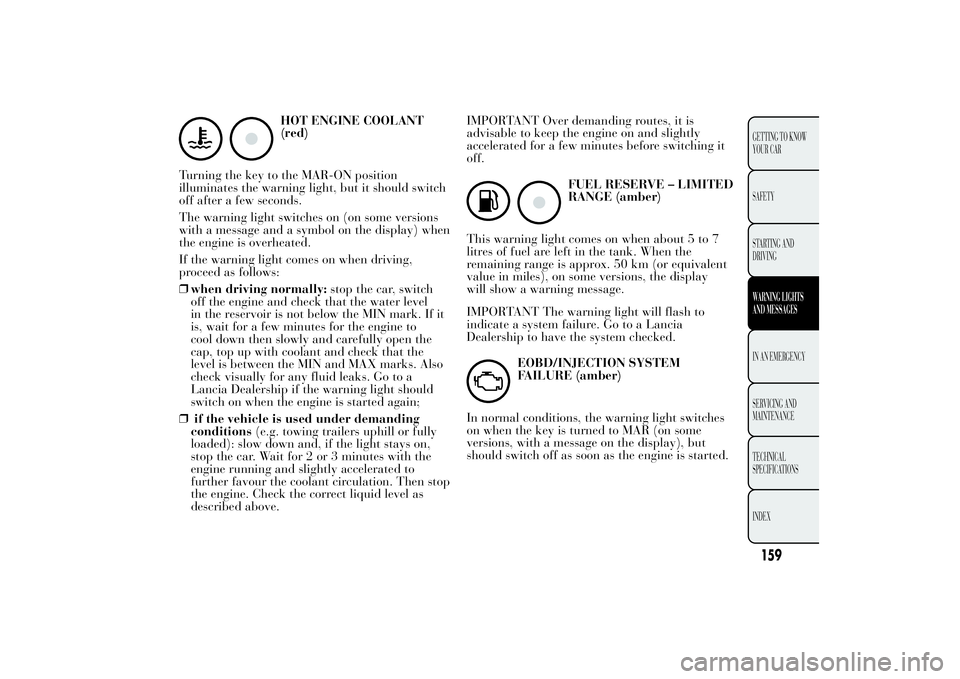
HOT ENGINE COOLANT
(red)
Turning the key to the MAR-ON position
illuminates the warning light, but it should switch
off after a few seconds.
The warning light switches on (on some versions
with a message and a symbol on the display) when
the engine is overheated.
If the warning light comes on when driving,
proceed as follows:
❒when driving normally:stop the car, switch
off the engine and check that the water level
in the reservoir is not below the MIN mark. If it
is, wait for a few minutes for the engine to
cool down then slowly and carefully open the
cap, top up with coolant and check that the
level is between the MIN and MAX marks. Also
check visually for any fluid leaks. Go to a
Lancia Dealership if the warning light should
switch on when the engine is started again;
❒if the vehicle is used under demanding
conditions(e.g. towing trailers uphill or fully
loaded): slow down and, if the light stays on,
stop the car. Wait for 2 or 3 minutes with the
engine running and slightly accelerated to
further favour the coolant circulation. Then stop
the engine. Check the correct liquid level as
described above.IMPORTANT Over demanding routes, it is
advisable to keep the engine on and slightly
accelerated for a few minutes before switching it
off.
FUEL RESERVE – LIMITED
RANGE (amber)
This warning light comes on when about 5 to 7
litres of fuel are left in the tank. When the
remaining range is approx. 50 km (or equivalent
value in miles), on some versions, the display
will show a warning message.
IMPORTANT The warning light will flash to
indicate a system failure. Go to a Lancia
Dealership to have the system checked.
EOBD/INJECTION SYSTEM
FAILURE (amber)
In normal conditions, the warning light switches
on when the key is turned to MAR (on some
versions, with a message on the display), but
should switch off as soon as the engine is started.
159GETTING TO KNOW
YOUR CAR
SAFETY
STARTING AND
DRIVINGWARNING LIGHTS
AND MESSAGESIN AN EMERGENCY
SERVICING AND
MAINTENANCE
TECHNICAL
SPECIFICATIONS
INDEX
Page 162 of 307
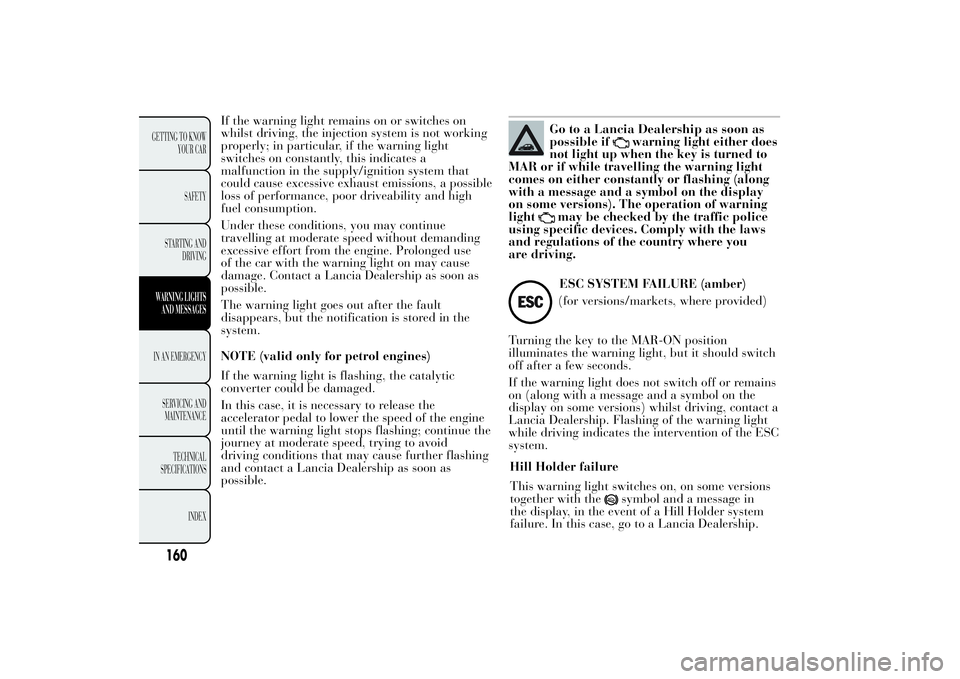
If the warning light remains on or switches on
whilst driving, the injection system is not working
properly; in particular, if the warning light
switches on constantly, this indicates a
malfunction in the supply/ignition system that
could cause excessive exhaust emissions, a possible
loss of performance, poor driveability and high
fuel consumption.
Under these conditions, you may continue
travelling at moderate speed without demanding
excessive effort from the engine. Prolonged use
of the car with the warning light on may cause
damage. Contact a Lancia Dealership as soon as
possible.
The warning light goes out after the fault
disappears, but the notification is stored in the
system.
NOTE (valid only for petrol engines)
If the warning light is flashing, the catalytic
converter could be damaged.
In this case, it is necessary to release the
accelerator pedal to lower the speed of the engine
until the warning light stops flashing; continue the
journey at moderate speed, trying to avoid
driving conditions that may cause further flashing
and contact a Lancia Dealership as soon as
possible.
Go to a Lancia Dealership as soon as
possible if
warning light either does
not light up when the key is turned to
MAR or if while travelling the warning light
comes on either constantly or flashing (along
with a message and a symbol on the display
on some versions). The operation of warning
light
may be checked by the traffic police
using specific devices. Comply with the laws
and regulations of the country where you
are driving.ESC SYSTEM FAILURE (amber)
(for versions/markets, where provided)
Turning the key to the MAR-ON position
illuminates the warning light, but it should switch
off after a few seconds.
If the warning light does not switch off or remains
on (along with a message and a symbol on the
display on some versions) whilst driving, contact a
Lancia Dealership. Flashing of the warning light
while driving indicates the intervention of the ESC
system.
160
GETTING TO KNOW
YOUR CAR
SAFETY
STARTING AND
DRIVINGWARNING LIGHTS
AND MESSAGESIN AN EMERGENCY
SERVICING AND
MAINTENANCE
TECHNICAL
SPECIFICATIONS
INDEX
Hill Holder failure
This warning light switches on, on some versions
together with the
symbol and a message in
the display, in the event of a Hill Holder system
failure. In this case, go to a Lancia Dealership.
Page 163 of 307
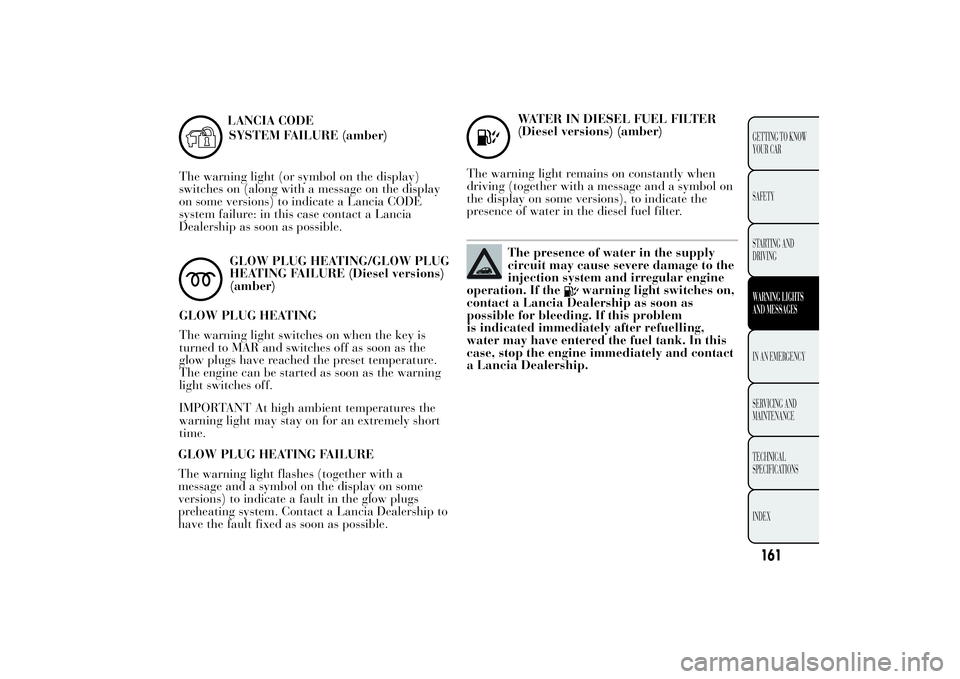
LANCIA CODE
The warning light (or symbol on the display)
switches on (along with a message on the display
on some versions) to indicate a Lancia CODE
system failure: in this case contact a Lancia
Dealership as soon as possible.GLOW PLUG HEATING/GLOW PLUG
HEATING FAILURE (Diesel versions)
(amber)
GLOW PLUG HEATING
The warning light switches on when the key is
turned to MAR and switches off as soon as the
glow plugs have reached the preset temperature.
The engine can be started as soon as the warning
light switches off.
IMPORTANT At high ambient temperatures the
warning light may stay on for an extremely short
time.
GLOW PLUG HEATING FAILURE
The warning light flashes (together with a
message and a symbol on the display on some
versions) to indicate a fault in the glow plugs
preheating system. Contact a Lancia Dealership to
have the fault fixed as soon as possible.
WATER IN DIESEL FUEL FILTER
(Diesel versions) (amber)
The warning light remains on constantly when
driving (together with a message and a symbol on
the display on some versions), to indicate the
presence of water in the diesel fuel filter.The presence of water in the supply
circuit may cause severe damage to the
injection system and irregular engine
operation. If the
warning light switches on,
contact a Lancia Dealership as soon as
possible for bleeding. If this problem
is indicated immediately after refuelling,
water may have entered the fuel tank. In this
case, stop the engine immediately and contact
a Lancia Dealership.
161GETTING TO KNOW
YOUR CAR
SAFETY
STARTING AND
DRIVINGWARNING LIGHTS
AND MESSAGESIN AN EMERGENCY
SERVICING AND
MAINTENANCE
TECHNICAL
SPECIFICATIONS
INDEX
SYSTEM FAILURE (amber)
Page 164 of 307

“DUALDRIVE” ELECTRIC POWER
STEERING FAILURE (red)
This warning light switches on when the ignition
key is turned to MAR, but it should switch off
after a few seconds.
If the warning light (or, on some versions, a
message and a symbol on the display) remains on,
you may not have steering assistance and the
effort required to operate the steering wheel could
be notably increased; steering is, however,
possible. In this case, contact a Lancia Dealership.
IMPORTANT In some circumstances, factors
independent of the electric power steering could
cause the warning light on the instrument panel to
switch on. In this case, stop the car immediately,
switch off the engine for about 20 seconds and
then restart the engine. If the warning light (or, on
some versions, a message and a symbol on the
display) remains on constantly, contact a Lancia
Dealership.
IMPORTANT After the battery is disconnected,
the steering must be initialised. The warning light
switches on to indicate this. To carry out this
procedure, simply turn the steering wheel all the
way from one end to the other or drive in a
straight line for about a hundred metres.
CRUISE CONTROL (green)
(for versions/markets, where provided)
This warning light switches on when the ignition
key is turned to MAR, but it should switch off
after a few seconds, if the Cruise Control is
deactivated.
The warning light switches on when the Cruise
Control ring nut is turned to the ON position (see
the “Cruise Control” paragraph in the "Knowing
your car" section). On some versions the display
shows the dedicated message.DPF (PARTICULATE FILTER) BEING
CLEANED
(only Diesel versions with DPF) (amber)
Turning the key to the MAR-ON position
illuminates the warning light, but it should switch
off after a few seconds.
The warning light (together with a message and a
symbol on the display on some versions) switches
on constantly to notify the driver that the DPF
system needs to eliminate captured pollutants
(particulate) through the regeneration process.
162
GETTING TO KNOW
YOUR CAR
SAFETY
STARTING AND
DRIVINGWARNING LIGHTS
AND MESSAGESIN AN EMERGENCY
SERVICING AND
MAINTENANCE
TECHNICAL
SPECIFICATIONS
INDEX
Page 165 of 307

The warning light does not come on during every
DPF regeneration, but only when driving
conditions require that the driver is notified. To
switch the warning light off, the car must be kept
moving until the regeneration process is
completed.
As an average, the process lasts fifteen minutes.
The best conditions to complete the regeneration
process are reached driving the car at about 60
km/h with engine speed over 2000 rpm.
When this warning light switches on, it does not
indicate a fault with the car and it should
therefore not be taken to a workshop. A specific
message will appear on the display when the
warning light comes on (for versions/markets,
where provided).
WARNING
The driving speed should always be
suitable to traffic conditions, weather
conditions and the driver should always
comply with the Highway Code. The engine
may be turned off while the DPF light is
on; however, repeated interruption of the
regeneration process may result in
premature exhaustion of engine oil. For this
reason, always wait until the warning light
switches off before stopping the engine as
described above. It is not a good idea to
complete DPF regeneration with the
car stationary.
GENERIC FAILURE INDICATION
(amber)
(for versions/markets, where provided)
The warning light switches on in the following
circumstances. In these cases contact a Lancia
Dealership to have the fault fixed as soon as
possible.
Speed limit exceeded
(for versions/markets, where provided)
The warning light switches on (together with a
message on the display) when the speed limit set
in the Setup Menu is exceeded.
When the car exceeds this value, on some versions
a message and a symbol are shown in the display
and an acoustic signal is emitted.
Fuel cut-off system intervention/fault
(for versions/markets, where provided)
The warning light switches on (together with a
message on the display) in the event of fuel cut-off
system intervention/fault.
Start&Stop failure
(for versions/markets, where provided)
The warning light switches on (together with a
message on the display) when a Start&Stop
system failure is detected.
163GETTING TO KNOW
YOUR CAR
SAFETY
STARTING AND
DRIVINGWARNING LIGHTS
AND MESSAGESIN AN EMERGENCY
SERVICING AND
MAINTENANCE
TECHNICAL
SPECIFICATIONS
INDEX
Page 166 of 307

Rain sensor failure
(for versions/markets, where provided)
The warning light switches on (together with a
message on the display) when a rain sensor failure
is detected.
Parking sensor failure
(for versions/markets, where provided)
The warning light switches on (together with a
message on the display) when a parking sensor
failure is detected.
Dusk sensor failure
(for versions/markets, where provided)
The warning light switches on (together with a
message on the display) when a dusk sensor
failure is detected.
Engine oil pressure sensor failure
Versions with multifunction display:the engine oil
pressure sensor failure is indicated by the
instrument panel warning light switching on.
Versions with reconfigurable multifunction
display:the engine oil pressure sensor failure is
indicated by the display icon switching on.
EXTERNAL LIGHT FAILURE
(amber)
This warning light switches on (on some versions
together with a message and a symbol in the
display) if a fault is detected in one of the
following lights:
❒daytime running lights (DRLs) (for versions/
markets, where provided);
❒side lights;
❒direction indicators;
❒rear fog lamps;
❒number plate lights;
❒brake lights (for versions with multifunction
display only).
The failure relating to these lights could be: one or
more blown bulbs, a blown protection fuse or a
break in the electrical connection.REAR FOG LIGHTS (amber)
The warning light switches on when the rear fog
lights are activated. The LED over the button
will also light up.
164
GETTING TO KNOW
YOUR CAR
SAFETY
STARTING AND
DRIVINGWARNING LIGHTS
AND MESSAGESIN AN EMERGENCY
SERVICING AND
MAINTENANCE
TECHNICAL
SPECIFICATIONS
INDEX
Page 170 of 307
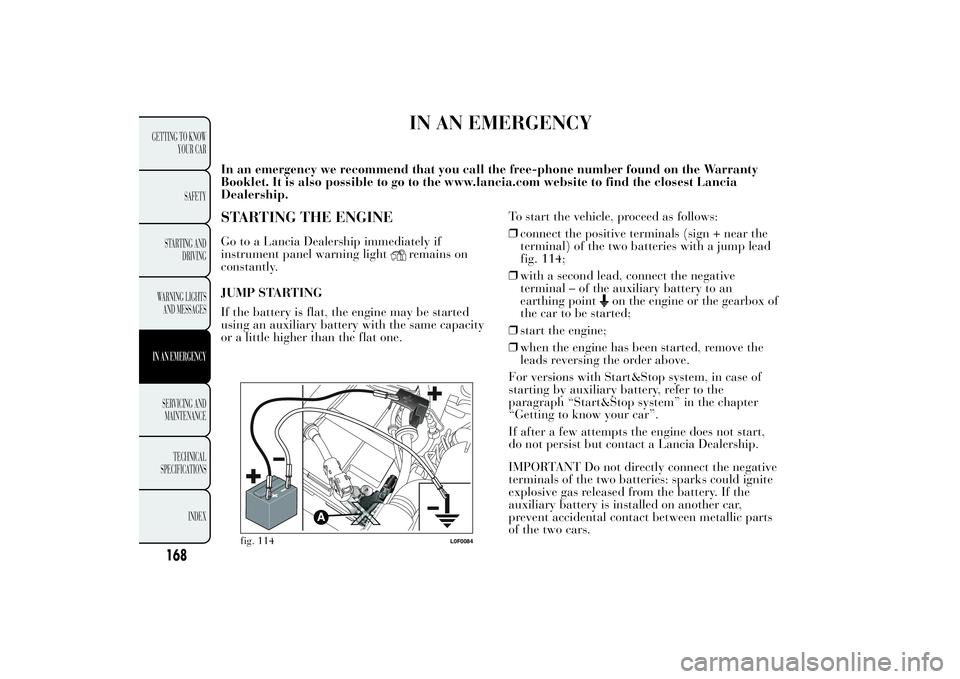
IN AN EMERGENCY
In an emergency we recommend that you call the free-phone number found on the Warranty
Booklet. It is also possible to go to the www.lancia.com website to find the closest Lancia
Dealership.STARTING THE ENGINEGo to a Lancia Dealership immediately if
instrument panel warning light
remains on
constantly.
JUMP STARTING
If the battery is flat, the engine may be started
using an auxiliary battery with the same capacity
or a little higher than the flat one.To start the vehicle, proceed as follows:
❒connect the positive terminals (sign + near the
terminal) of the two batteries with a jump lead
fig. 114;
❒with a second lead, connect the negative
terminal – of the auxiliary battery to an
earthing point
on the engine or the gearbox of
the car to be started;
❒start the engine;
❒when the engine has been started, remove the
leads reversing the order above.
For versions with Start&Stop system, in case of
starting by auxiliary battery, refer to the
paragraph “Start&Stop system” in the chapter
“Getting to know your car”.
If after a few attempts the engine does not start,
do not persist but contact a Lancia Dealership.
IMPORTANT Do not directly connect the negative
terminals of the two batteries: sparks could ignite
explosive gas released from the battery. If the
auxiliary battery is installed on another car,
prevent accidental contact between metallic parts
of the two cars.
fig. 114
L0F0084
168
GETTING TO KNOW
YOUR CAR
SAFETY
STARTING AND
DRIVING
WARNING LIGHTS
AND MESSAGESIN AN EMERGENCYSERVICING AND
MAINTENANCE
TECHNICAL
SPECIFICATIONS
INDEX
Page 171 of 307
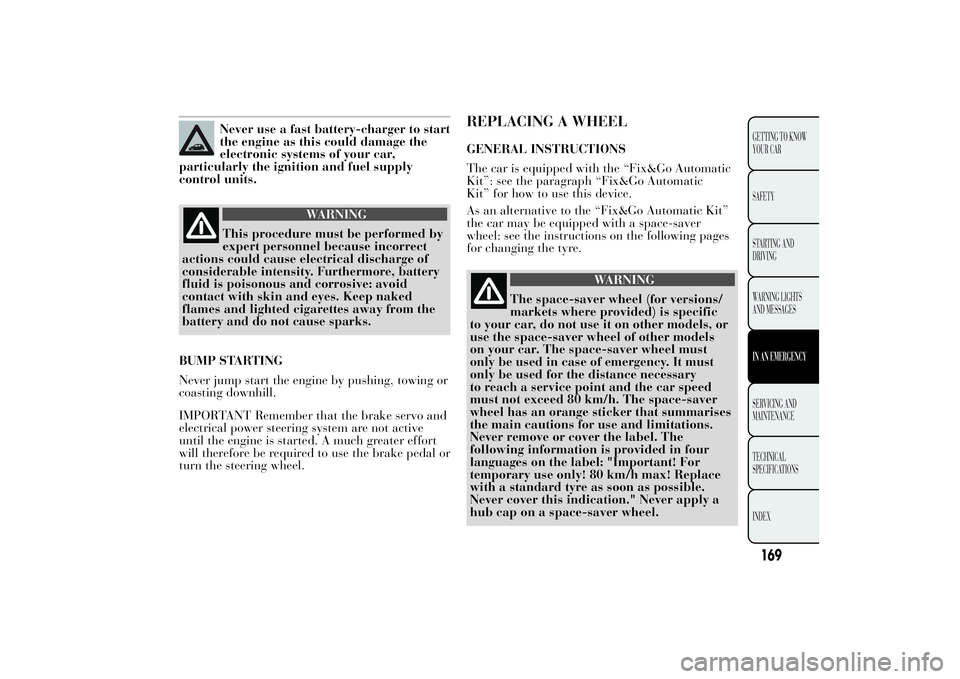
Never use a fast battery-charger to start
the engine as this could damage the
electronic systems of your car,
particularly the ignition and fuel supply
control units.
WARNING
This procedure must be performed by
expert personnel because incorrect
actions could cause electrical discharge of
considerable intensity. Furthermore, battery
fluid is poisonous and corrosive: avoid
contact with skin and eyes. Keep naked
flames and lighted cigarettes away from the
battery and do not cause sparks.
BUMP STARTING
Never jump start the engine by pushing, towing or
coasting downhill.
IMPORTANT Remember that the brake servo and
electrical power steering system are not active
until the engine is started. A much greater effort
will therefore be required to use the brake pedal or
turn the steering wheel.
REPLACING A WHEELGENERAL INSTRUCTIONS
The car is equipped with the “Fix&Go Automatic
Kit”: see the paragraph “Fix&Go Automatic
Kit” for how to use this device.
As an alternative to the “Fix&Go Automatic Kit”
the car may be equipped with a space-saver
wheel: see the instructions on the following pages
for changing the tyre.
WARNING
The space-saver wheel (for versions/
markets where provided) is specific
to your car, do not use it on other models, or
use the space-saver wheel of other models
on your car. The space-saver wheel must
only be used in case of emergency. It must
only be used for the distance necessary
to reach a service point and the car speed
must not exceed 80 km/h. The space-saver
wheel has an orange sticker that summarises
the main cautions for use and limitations.
Never remove or cover the label. The
following information is provided in four
languages on the label: "Important! For
temporary use only! 80 km/h max! Replace
with a standard tyre as soon as possible.
Never cover this indication." Never apply a
hub cap on a space-saver wheel.
169GETTING TO KNOW
YOUR CAR
SAFETY
STARTING AND
DRIVING
WARNING LIGHTS
AND MESSAGESIN AN EMERGENCYSERVICING AND
MAINTENANCE
TECHNICAL
SPECIFICATIONS
INDEX
Page 173 of 307
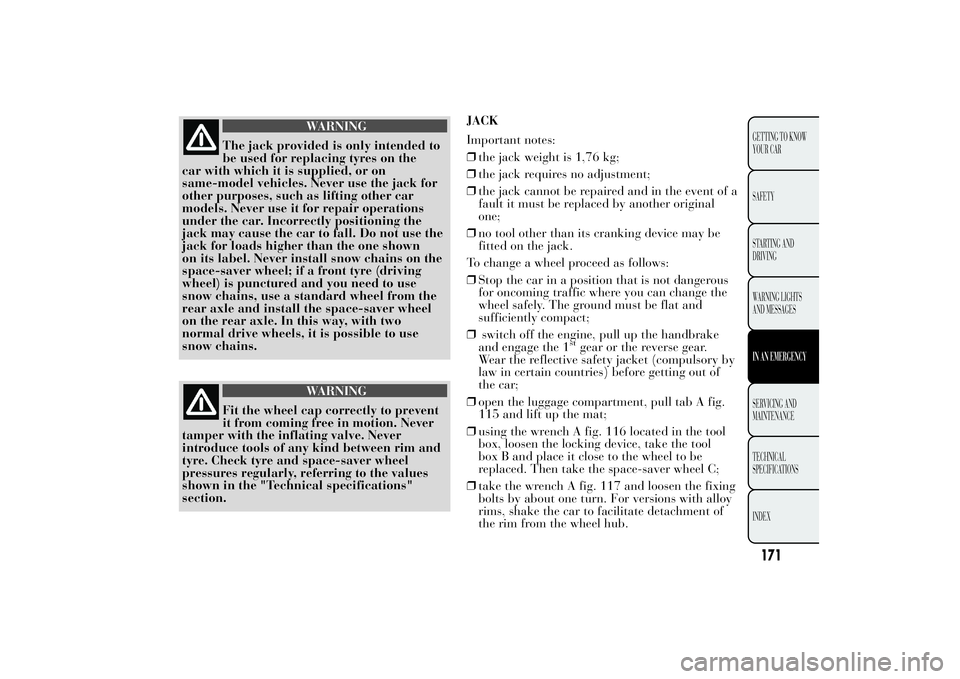
WARNING
The jack provided is only intended to
be used for replacing tyres on the
car with which it is supplied, or on
same-model vehicles. Never use the jack for
other purposes, such as lifting other car
models. Never use it for repair operations
under the car. Incorrectly positioning the
jack may cause the car to fall. Do not use the
jack for loads higher than the one shown
on its label. Never install snow chains on the
space-saver wheel; if a front tyre (driving
wheel) is punctured and you need to use
snow chains, use a standard wheel from the
rear axle and install the space-saver wheel
on the rear axle. In this way, with two
normal drive wheels, it is possible to use
snow chains.
WARNING
Fit the wheel cap correctly to prevent
it from coming free in motion. Never
tamper with the inflating valve. Never
introduce tools of any kind between rim and
tyre. Check tyre and space-saver wheel
pressures regularly, referring to the values
shown in the "Technical specifications"
section.JACK
Important notes:
❒the jack weight is 1,76 kg;
❒the jack requires no adjustment;
❒the jack cannot be repaired and in the event of a
fault it must be replaced by another original
one;
❒no tool other than its cranking device may be
fitted on the jack.
To change a wheel proceed as follows:
❒Stop the car in a position that is not dangerous
for oncoming traffic where you can change the
wheel safely. The ground must be flat and
sufficiently compact;
❒switch off the engine, pull up the handbrake
and engage the 1
stgear or the reverse gear.
Wear the reflective safety jacket (compulsory by
law in certain countries) before getting out of
the car;
❒open the luggage compartment, pull tab A fig.
115 and lift up the mat;
❒using the wrench A fig. 116 located in the tool
box, loosen the locking device, take the tool
box B and place it close to the wheel to be
replaced. Then take the space-saver wheel C;
❒take the wrench A fig. 117 and loosen the fixing
bolts by about one turn. For versions with alloy
rims, shake the car to facilitate detachment of
the rim from the wheel hub.
171GETTING TO KNOW
YOUR CAR
SAFETY
STARTING AND
DRIVING
WARNING LIGHTS
AND MESSAGESIN AN EMERGENCYSERVICING AND
MAINTENANCE
TECHNICAL
SPECIFICATIONS
INDEX
Page 179 of 307

WARNING
The cylinder contains ethyl glycol.
Contains latex: may cause an allergic
reaction. Harmful if swallowed. Eye irritant.
May cause irritation if inhaled or on contact.
Avoid contact with eyes, skin and clothes.
In the event of contact, wash immediately
with plenty of water. If ingested, do not
induce vomiting. Rinse out your mouth,
drink large quantities of water and seek
immediate medical attention. Keep away
from children. The product must not be used
by asthmatics. Do not inhale the vapours
during insertion and suction. Call a doctor
immediately if allergic reactions are noted.
Store the canister in its proper
compartment, away from sources of heat.
The sealant fluid has an expiry date.
Replace the bottle containing out-of-date
sealant fluid.Dispose of the bottle and the sealant
liquid properly. Have the sealing fluid
and the cylinder disposed of in
compliance with national and local
regulations.INFLATING PROCEDURE
WARNING
Put on the protective gloves provided
together with quick tyre repair kit.
Proceed as follows:
❒Pull up the handbrake.Unscrew the tyre
valve cap, take out the flexible filler pipe A fig.
124 and tighten the ring nut B on the tyre valve;
❒make sure that the compressor switch A fig. 125
is in position 0 (off), start the engine, plug into
the power socket in the central tunnel fig. 126
and operate the compressor, turning switch A to
position I (on). Inflate the tyre to the pressure
specified in the "Inflation pressure" paragraph
in the "Technical specifications" section. Check
fig. 124
L0F0176
177GETTING TO KNOW
YOUR CAR
SAFETY
STARTING AND
DRIVING
WARNING LIGHTS
AND MESSAGESIN AN EMERGENCYSERVICING AND
MAINTENANCE
TECHNICAL
SPECIFICATIONS
INDEX